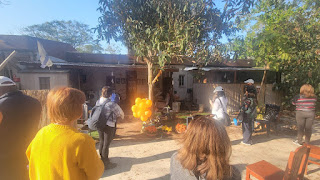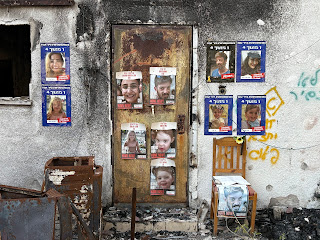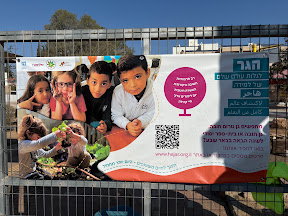Interfaith Mission Day Three - Shared Jewish -Christian Origins in the North:
Today we explored our common origins in the land of Israel. A very early start found us soon after sunrise at the Jordan river, site of both the baptism of Jesus and the crossing of Joshua into the land.
Unitarian Minister Robin Tanner, and I each took a moment to contemplate the country of Jordan, living in Peace with Israel, just 30 feet across the river...
As a group, we reflected on the waters of purity in traditional and ancient Judaism, and how the discovery of mikva'ot rather than mere cisterns often pin pointed ancient Jewish habitation in the Land of Israel. We discussed the role of living waters in celebration of a woman's fertility, in response to death, and in the ancient system of sacrificial purity. In the context of affirming life, and reestablishing our place in community, we explored each of our minister and priest's own relationship with baptism and the river. Ceremonies and beliefs were shared regarding dedication to God, receipt of the spirit, admission to the sacred community and more. Participants had an opportunity to enter the river, and - a wonderful moment - to great Jordanian caretakers of the same site a mere 30 feet away from us across the river. It was a place of peace and tranquility in a torn moment of time.
Rabbi Abby Treu, and Hindu leader Fal Pandya, share a moment.
From the Jordan we headed North, just past Tiberius, to the Mt. of the Beatitudes.
On the Mount of the Beatitudes my friend and colleague Father Peter Wehrle of the Roman Catholic church Our Lady of the Lake in Verona lead us in a study of the sermon on the mount, with its call for human value, modesty, faithfulness and more.
He also taught us about its passage regarding divorce, which I was able to place in the context of a debate between Hillel and Shammai in the Mishnah. It was a live topic in the time of the late second temple, and the mixed Jewish and non-Jewish crowd surely would have been interested in - and challenged by - the young teacher's take on the debate.
We moved on to Capernaum, where a magnificent Bynzantine era synagogue stood atop a second temple era synagogue's foundation. This is a site I have visited with my own congregation, and we sat under the trees and explored the New Testament stories of Jesus entereing the synagogue here and teaching from Isaiah . What did it mean that the people (Jews) were "astounded"? Why did some, evidently, grow angry? Why would some follow him and others turn away?
Dr Atkins leading us in study
We explored the context of reading from the prophets in synagogue, understood the possible "normalcy" of Jesus's behavior as a Jewish man, and the potential reasons why what he did may of be out of the ordinary. We asked if he was a positive provocateur, an innocent, or anything else. We asked each other what it means to be a positive provocateur, and especially if we are in another's house of worship or not.
Stunningly, this synagogue also stands face to face with an ancient Church, tied directly to the life of Jesus and his apostle Peter's family. For centuries - even difficult centuries - these two houses lived in peace and proximity to each other. It was only the invasion of the Persian empire - an outside force - that destroyed them both.
Rabbi Daniel Cohen is the Senior Rabbi of Temple Sharey Tefilo-Israel (TSTI) in South Orange, New Jersey.
For lunch we met with leaders of the Druze community and learned of their place in Israeli society, including their army service and loyalty to the state.


.jpeg)
We explored education, and their feelings about the "Jewish nation state law" that was raised by the coalition government. They question what it says about their place and their loyalty, and suggested respectful revisions to those political positions.
Finally we moved on to Tel Aviv, where we went to Hostage Square, and then met with Eli David, the older brother of Evyatar David who remains a hostage in Gaza to this day.
Evyatar's posters have been on our synagogue's front lawn, so his face is known to most of us. We learned about his love of music and people, and the family's experience of learning immediately that he was taken alive to Gaza. He is not on the list for release during phase 1 of the current hostage "deal" and we all pray for his immediate and safe return, with all 82 of the remaining hostages. The fact that Evyatar's brother, seemingly randomly, was the one to speak with us felt like so much more than a coincidence.
We celebrated the return, today, of Agam Berger, Arbel Yehud, Gadi Moses, Watchara Sriaoun, Pongsak Thaenna, Sathian Suwannakham, Surasak Rumnao and Bannawat Saethao. 482 days in unjust captivity. and 82 more to come home.
At our closing dinner, we expressed our tremendous gratitude to the Jewish Federation of GMW, whose support and vision made this trip possible. Our ability as clergy leaders to experience our past and our present together, unvarnished and real, is of immeasurable benefit to each of us, our ministries, our communities and the land of Israel.
I come home with friends and allies, across a dozen denominations, who understand and empathize with our situation, and who will speak and act in favor of the right and the good in the current conflict. They each shared at our dinner what they saw, learned or felt that they fell their own congregation must hear from them. I look forward to seeing the fruits of their labors in the days ahead.
I write this last post from the departure hall of Ben Gurion airport, and I am once again awed at the miracle of our people's resurrection in history to landed sovereignty and independence. It is a journey once again soaked in the blood of the innocent - and the guilty. But the life of an Israeli child, learning the values of our people in the land of our people, is infinitely wonderful today despite the troubles. We see a thriving and blossoming pluralistic and democratic society that has emerged with the support of not just the Jewish people but many many Christian and other allies and supporters. We see a land struggling to shake off hatred and bias, from without and from within, but whose foundations are firm. But most of all we see a land where our faith lives, and God reaches out for our future.
I return enlivened and gratified that our love and support of Israel has grown through this interfaith mission, and that our voices are being heard.
None of this would have been possible without to complete support, sponsorship and advocacy of the Jewish Federation of Greater MetroWest, who funded, designed and led this remarkable experience.
Please consider supporting the Jewish Federation here. GMW Donations
As I told my colleagues when we left the city this morning.... Next year in Jerusalem.
Father Peter Wehrle and Bishop Raymond Wyatt, ready for their next adventure!
Gratefully Submitted by,
Rabbi Robert L Tobin
Rosh Chodesh Tevet, 5785
January, 2025







.jpeg)
.jpeg)

.jpeg)
.jpeg)
.jpeg)











.jpeg)
.jpeg)




.jpeg)



.jpeg)








.jpeg)















.jpeg)







.jpeg)




